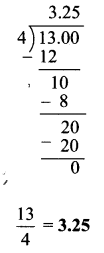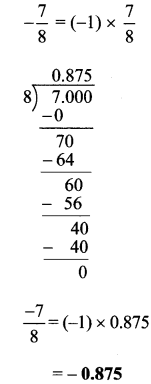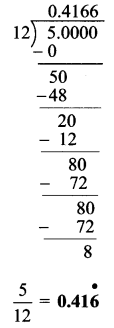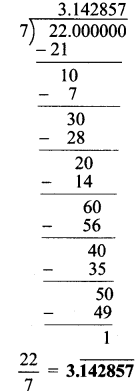Balbharti Maharashtra State Board Class 7 Maths Solutions
covers the 7th Std Maths Practice Set 24 Answers Solutions Chapter 5 Operations on Rational Numbers.
Question 1.
Write the following rational numbers in decimal form.
i. \(\frac { 13 }{ 4 }\)
ii. \(\frac { -7 }{ 8 }\)
iii. \(7\frac { 3 }{ 5 }\)
iv. \(\frac { 5 }{ 12 }\)
v. \(\frac { 22 }{ 7 }\)
vi. \(\frac { 4 }{ 3 }\)
vii. \(\frac { 7 }{ 9 }\)
Solution:
i. \(\frac { 13 }{ 4 }\)

ii. \(\frac { -7 }{ 8 }\)

iii. \(7\frac { 3 }{ 5 }\)

iv. \(\frac { 5 }{ 12 }\)

v. \(\frac { 22 }{ 7 }\)

vi. \(\frac { 4 }{ 3 }\)

vii. \(\frac { 7 }{ 9 }\)

Maharashtra Board Class 7 Maths Chapter 5 Operations on Rational Numbers Practice Set 24 Intext Questions and Activities
Question 1.
Without using division, can we tell from the denominator of a fraction, whether the decimal form of the fraction will be a terminating decimal? Find out. (Textbook pg. no. 40)
Solution:
If the prime factorization of the denominator of a fraction has only factors as 2 or 5 or a combination of 2 and 5 then the decimal form of that fractional will be a terminating decimal form.
Consider the fractions \(\frac { 17 }{ 20 }\) and \(\frac { 19 }{ 6 }\)
Now, 20 = 2 x 2 x 5, and 6 = 2 x 3
∴ \(\frac { 17 }{ 20 }\) is terminating decimal form while \(\frac { 19 }{ 6 }\) is recurring decimal form.
covers the 7th Std Maths Practice Set 24 Answers Solutions Chapter 5 Operations on Rational Numbers.
Question 1.
Write the following rational numbers in decimal form.
i. \(\frac { 13 }{ 4 }\)
ii. \(\frac { -7 }{ 8 }\)
iii. \(7\frac { 3 }{ 5 }\)
iv. \(\frac { 5 }{ 12 }\)
v. \(\frac { 22 }{ 7 }\)
vi. \(\frac { 4 }{ 3 }\)
vii. \(\frac { 7 }{ 9 }\)
Solution:
i. \(\frac { 13 }{ 4 }\)

ii. \(\frac { -7 }{ 8 }\)

iii. \(7\frac { 3 }{ 5 }\)

iv. \(\frac { 5 }{ 12 }\)

v. \(\frac { 22 }{ 7 }\)

vi. \(\frac { 4 }{ 3 }\)

vii. \(\frac { 7 }{ 9 }\)

Maharashtra Board Class 7 Maths Chapter 5 Operations on Rational Numbers Practice Set 24 Intext Questions and Activities
Question 1.
Without using division, can we tell from the denominator of a fraction, whether the decimal form of the fraction will be a terminating decimal? Find out. (Textbook pg. no. 40)
Solution:
If the prime factorization of the denominator of a fraction has only factors as 2 or 5 or a combination of 2 and 5 then the decimal form of that fractional will be a terminating decimal form.
Consider the fractions \(\frac { 17 }{ 20 }\) and \(\frac { 19 }{ 6 }\)
Now, 20 = 2 x 2 x 5, and 6 = 2 x 3
∴ \(\frac { 17 }{ 20 }\) is terminating decimal form while \(\frac { 19 }{ 6 }\) is recurring decimal form.